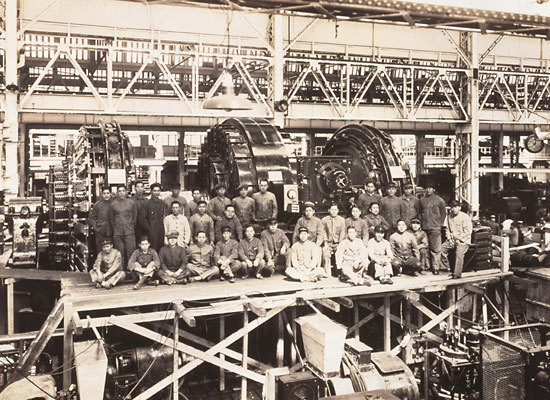The War Effort in the Japanese Homeland
By: Rickey Black
During the Second World War, the Japanese empire took the islands of the pacific by storm thus thrusting Japan onto the global stage of empires. Their sudden emergence couldn’t have been possible if not for the combined efforts of those fueling the war machine from the home front. Over the duration of these expansions and conflicts, normal every day, noncombatant, Japanese civilians stepped up to fulfill the demand of the Japanese military. By August 1942, Imperial Japan had expanded its reach and influence to the nations of Manchuria, China, Korea, Burma, Thailand, French Indochina, Sumatra, Saigon, Malaya, Borneo, the Philippines, and New Guinea. Through clear skies and fire raining down upon them from United States air raids, the Japanese war machine surely would have failed without the Japanese civilians being committed to continuously develop and construct a means for the soldiers to wage their conquest and war.
Initially there was not much demand upon the everyday citizens of Japan to fuel the war machine, but then they found success. As the Japanese military fought wars in the late 19th century and early 20th century, their desire to expand the Japanese Empire grew. With the increased desire of an expanded Japanese Empire came the need for an increased focus on industry to produce the means by which the war machine can drive and thrive upon. One such area of need being an increased Navy.[1] As an island nation naval superiority was paramount, but this could not be achieved without the support and contributions from those at home fueling the war machine and building the tools.
The people of Japan truly proved to push through the adversity that they were facing on the home front during this period. As most know, The Great Depression ravished the United States economy from 1929 until 1939. However, The Great Depression affected far more than just the United States, it was a global event which impacted the growth and development of most of the industrial nations of the world. That said, Japan suffered the impact less than other countries did, but Japan was still hurting from The Great Depression.[2] The recession should have harmed the Japanese economy, but as the gears of the Japanese began turning in the early 1930’s the noncombatants stepped up to the plate to fuel the machine.[3] These Japanese noncombatants were so successful in fueling the Japanese war machine that the economy grew by 5% of GDP per year, and most of the industrial growth was intended for military use.
During the rage of the war machine, it can be easy to miss the significance of some of the individual cogs of the machine. One such type of cog being the people who worked relentlessly to develop and produce more and more poison for the Japanese military and its troops. Nakajima Yoshimi was one of the individuals tasked with developing and producing the poison gas for the army.[4] He worked in the same military factory from 1937 until 1944, all the while working tirelessly around the clock to maintain a flow of poison gas to supply to the troops on the front lines. Even though he worked relentlessly through all conditions, "[he] was really happy when [he] started that job.” Although Yoshimi focused mainly on creating mustard gas, his factory was also responsible for producing suffocating gas, tear gas, and asphyxiating gas. These gases were made by these normal Japanese noncombatants, and yet Yoshimi’s dedication to the Japanese war machine in the late 1930’s and early 1940’s contributed to the literal tons of gas deployed as a weapon used against their enemies, granted nowhere near to the scale of World War I.
As one of the natural consequences of war, a means to an end had to be found. In order to achieve an end, the Japanese war machine had to be halted which meant the Japanese noncombatants had to be stopped as well. To achieve this, the United States military forces set out to break the Japanese war machine on the home front. Due to the devotion of the Japanese people as a whole, the United States military planned to invade unless a better means could be found. Thus, leading the United States military to drop the atomic bombs on Hiroshima, August 6, 1945, and Nagasaki, August 9, 1945.[5] The devastation ultimately brought forth by the American forces ultimately resulted in the destruction of about 40 percent of Japan’s industrial plants and infrastructure, thus setting Japan back roughly fifteen years in production.
Bibliography
BBC - History - World Wars: Japan's Quest for Empire. (2011, March 30).
Browne, R. (2016, May 27). Why did the U.S. bomb Hiroshima? Retrieved from CNN.
Japan - The Economy - PATTERNS OF DEVELOPMENT. (n.d.). Retrieved from http://countrystudies.us/japan/98.htm
Japan's Territorial Expansion 1931-1942. (2014, December 8). Retrieved from Worldview powered by Stratford
Nakajima Yoshimi “Poison-Gas Island” by Cook, Haruko Taya., and Theodore Failor. Cook. Japan at War: An Oral History. London: Phoenix, 2000.
[1] BBC - History - World Wars: Japan's Quest for Empire. (2011, March 30).
[2] Japan - The Economy - PATTERNS OF DEVELOPMENT. (n.d.). Retrieved from http://countrystudies.us/japan/98.htm
[3] Japan's Territorial Expansion 1931-1942. (2014, December 8). Retrieved from Worldview powered by Stratford
[4] Nakajima Yoshimi “Poison-Gas Island” by Cook, Haruko Taya., and Theodore Failor. Cook. Japan at War: An Oral History. London: Phoenix, 2000.
[5] Browne, R. (2016, May 27). Why did the U.S. bomb Hiroshima? Retrieved from CNN
Oral History
This is an oral history from the collection of oral histories held within Japan at War by Haruko Taya Cook. Nakajima sheds insight into the life of a Japanese poison maker during World War II.
